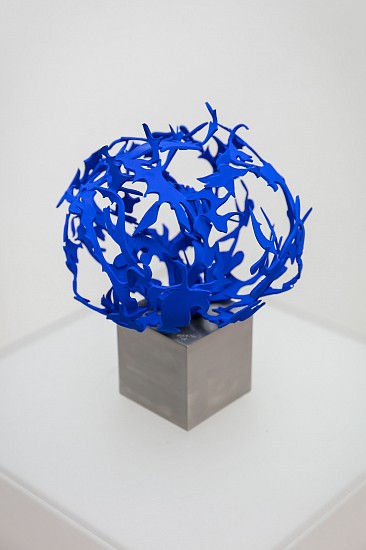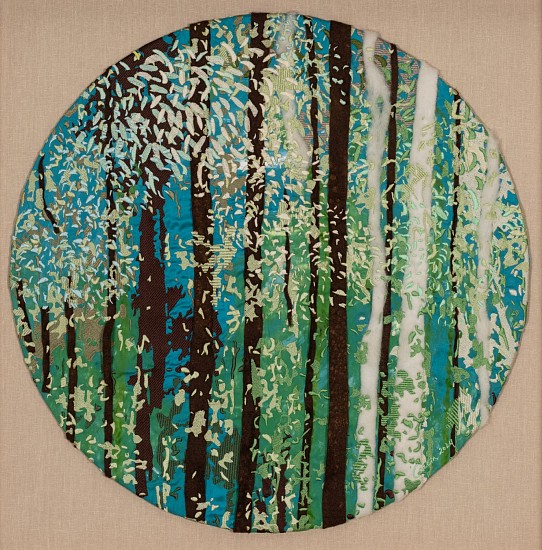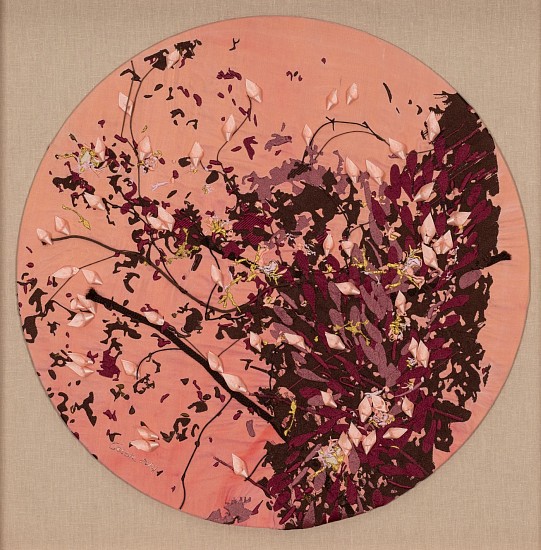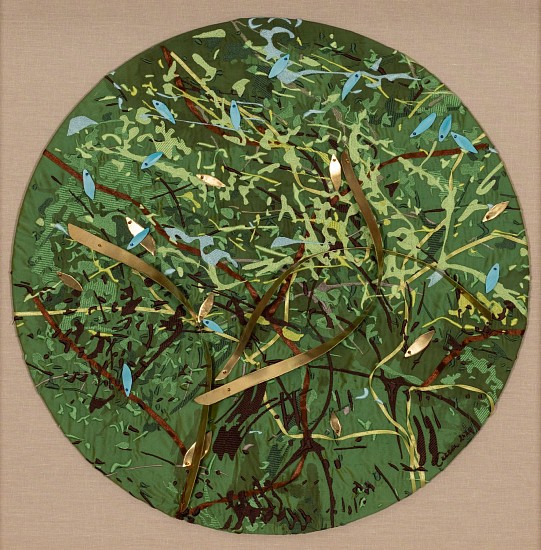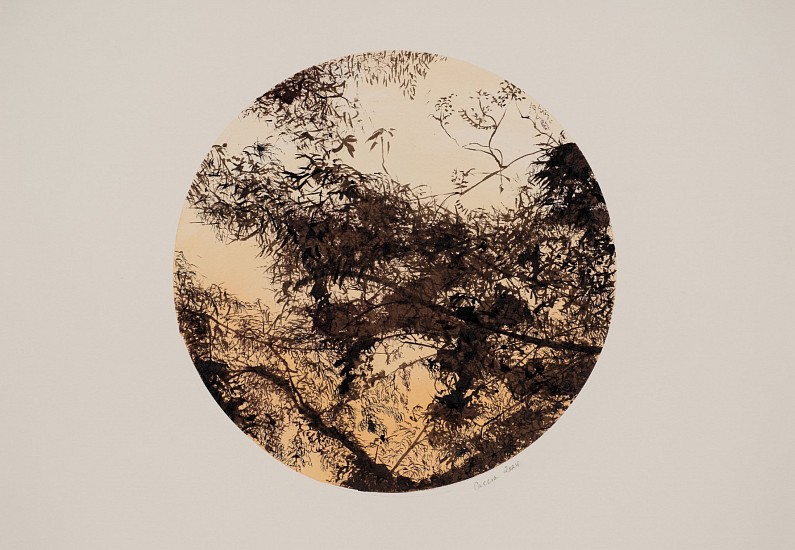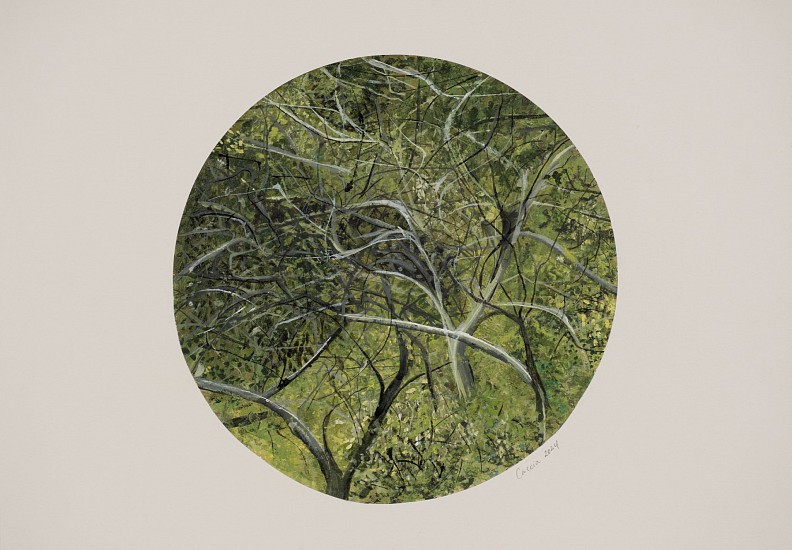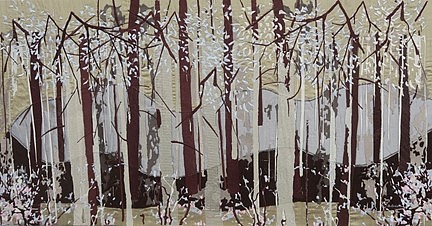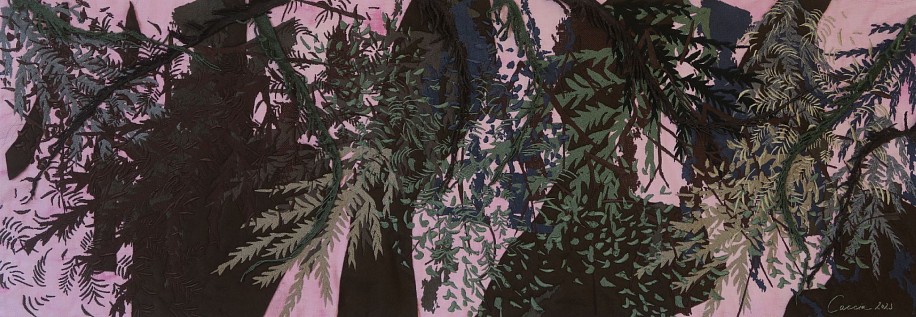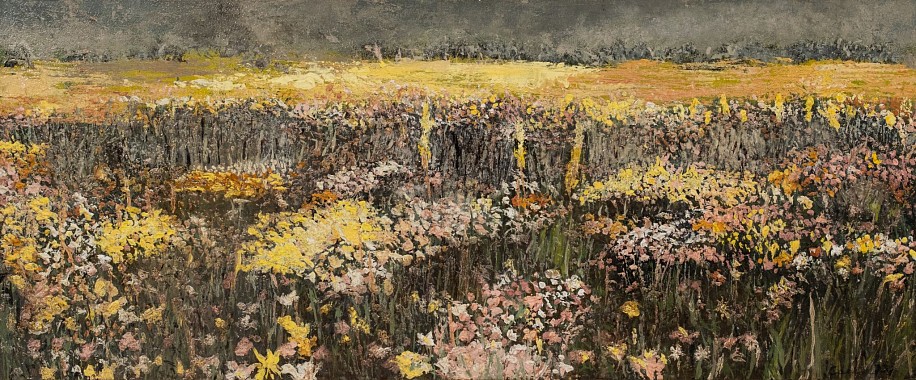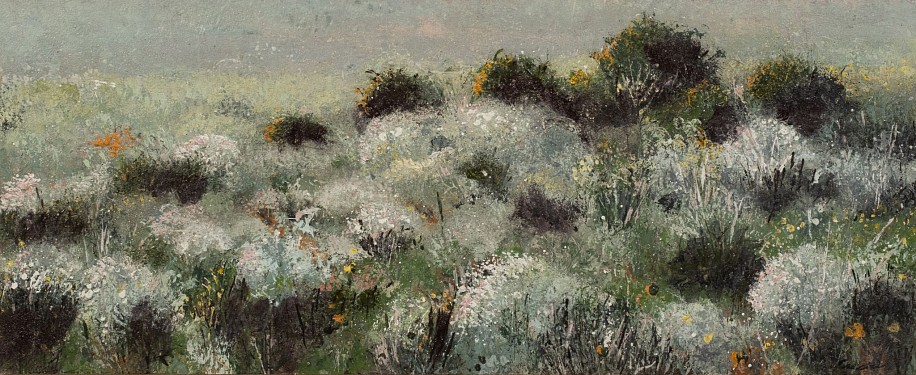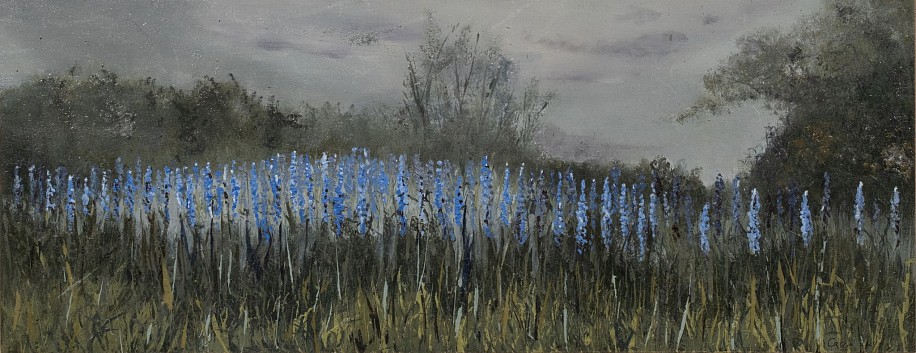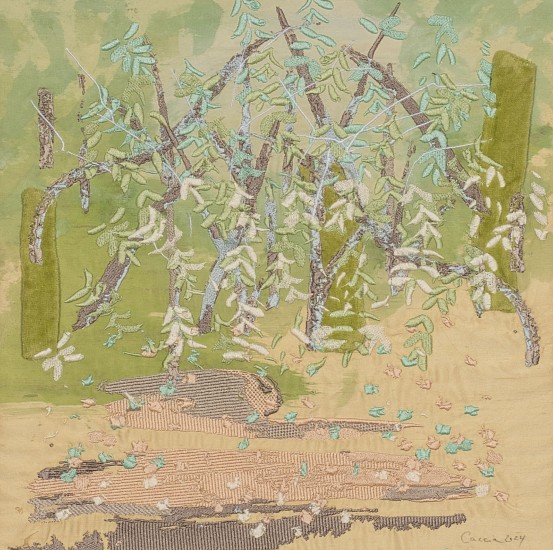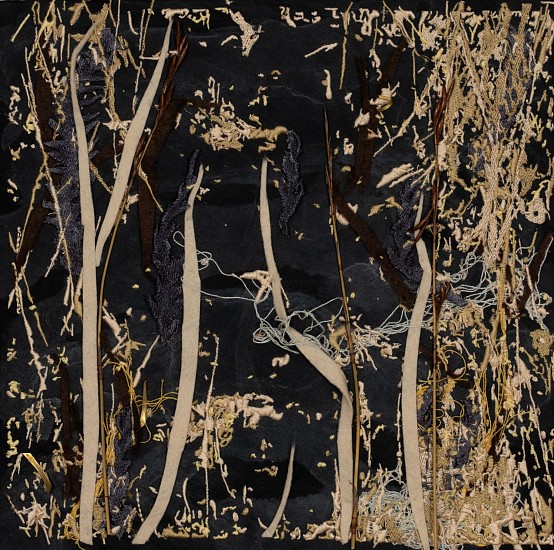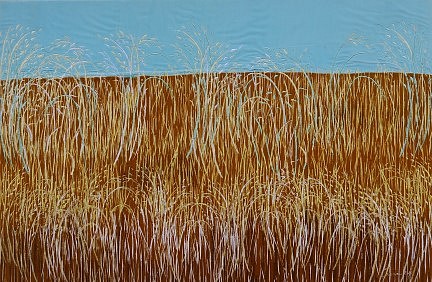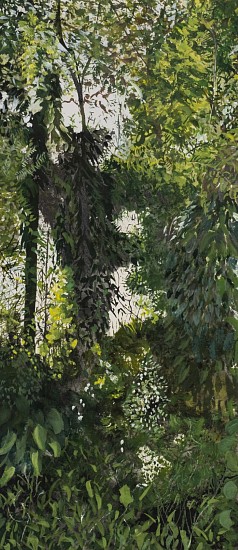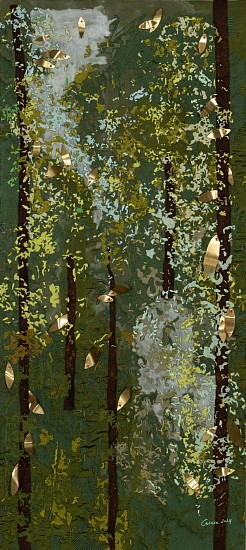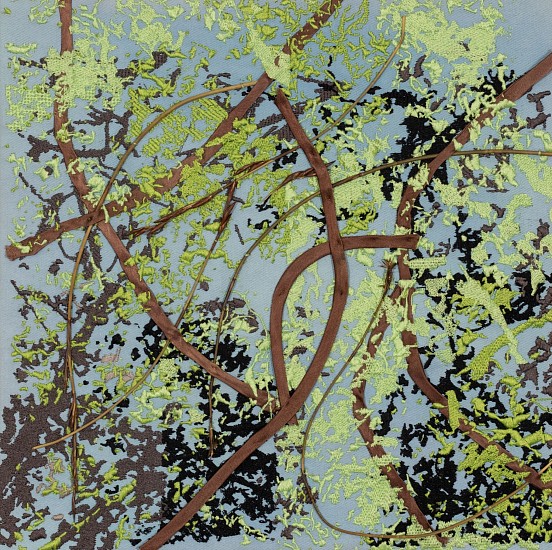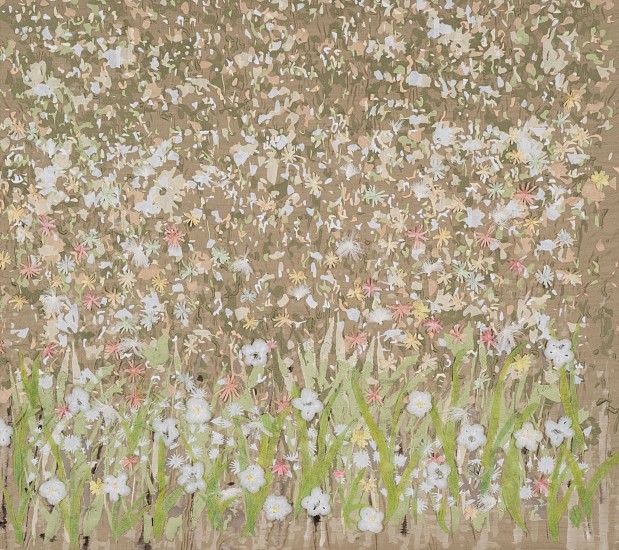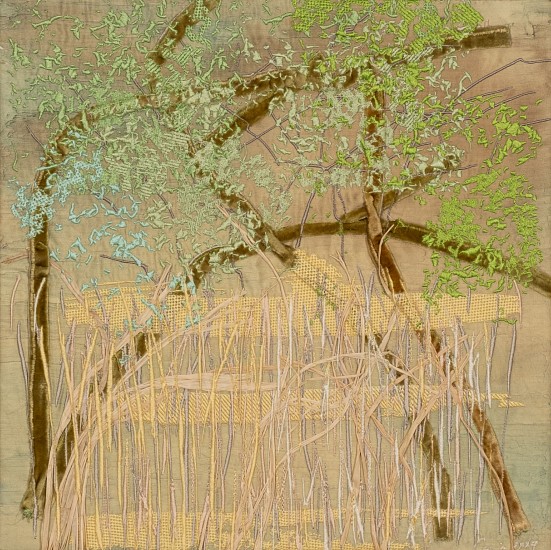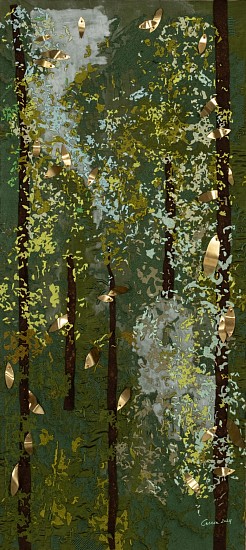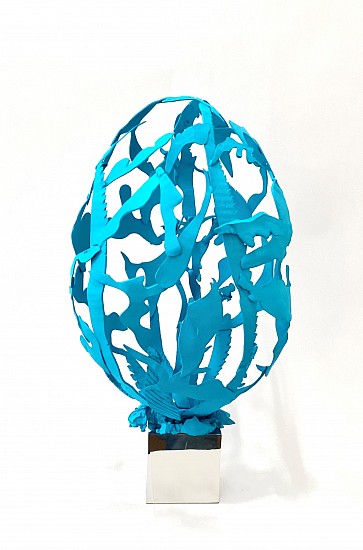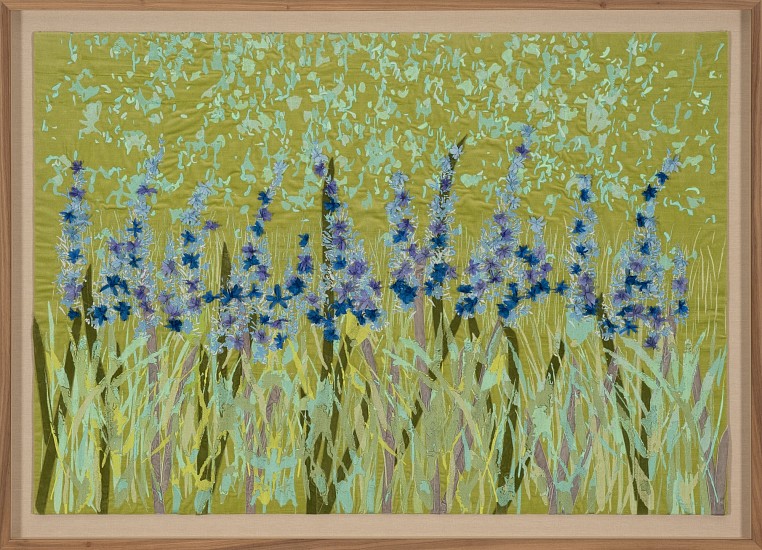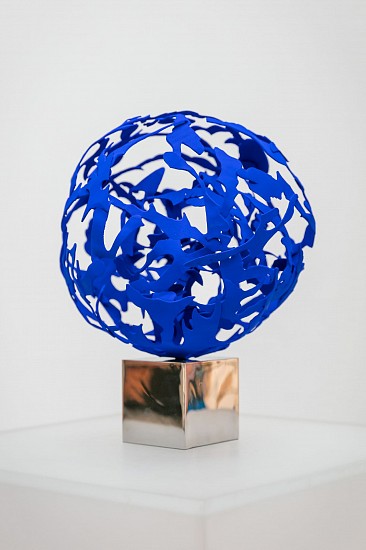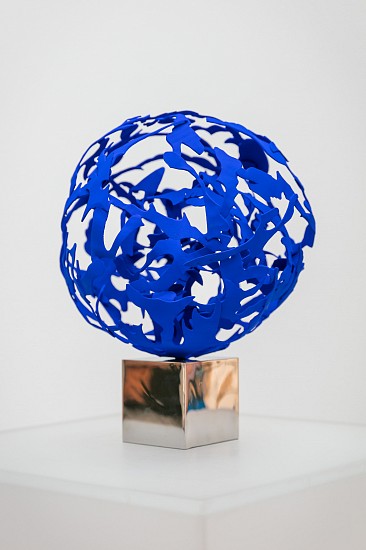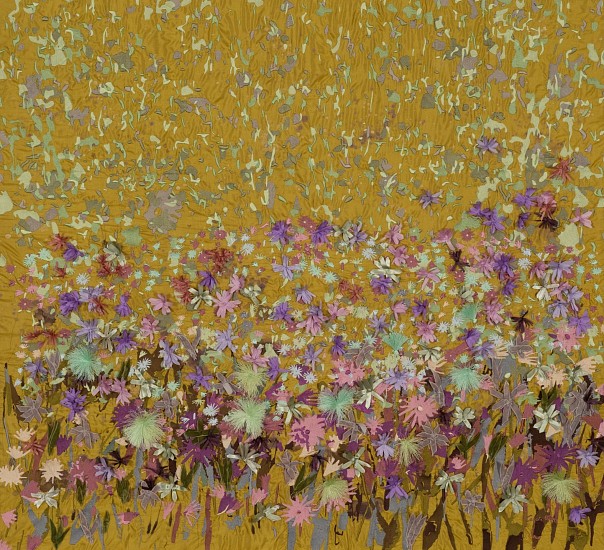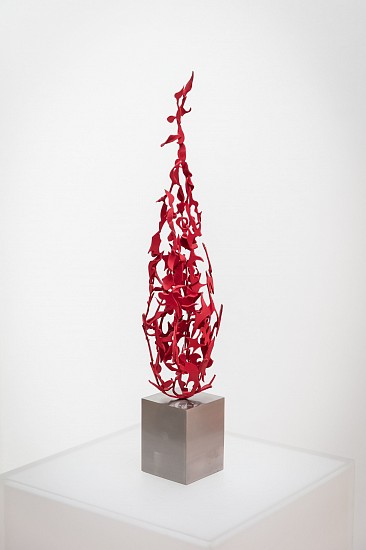ARABELLA CACCIA




ARABELLA CACCIA, Window to the Wood II
Embroidery and appliqué on hand-painted silk, 54 x 54 cm
Cape Town-based artist Arabella Caccia’s work is fundamentally rooted in the importance of process. Using an ‘alphabet’ of glyphs derived from her study of nature, she employs two- and three-dimensional mark-making to express a state of being. This journey is brought to life through a variety of mediums, including oil, embroidery, and mixed media.
"My hope is that my art and the journey that shaped it inspires others to cultivate a playful curiosity about nature”, says Caccia. “I believe that focused, meditative creation leads to work of honesty and integrity. Through my work, I aim to invite others to experience the beauty and magic of nature with the same appreciation I've been fortunate to encounter. It is my hope that my creations serve as a bridge, connecting people to the beauty and magic of the natural world."



ARABELLA CACCIA, Window at Dawn II
Embroidery and appliqué on hand-painted silk, 54 x 54 cm
Caccia draws inspiration from the natural light that generously blesses the southern tip of the African continent where she lives, and the wild places to which she travels to find solitude and silence.
By immersing herself in wild places, undisturbed by human activity, Caccia seeks to deepen her exploration of the natural world, its flora, rock and land formations, and so refine and challenge the language and the expression of her work. This journey is brought to life through a variety of mediums, including oil, embroidery, and mixed media.




ARABELLA CACCIA, Window to the Forest II
Embroidery and appliqué on hand-painted silk, 54 x 54 cm
Caccia draws inspiration from the natural light that generously blesses the southern tip of the African continent where she lives, and the wild places to which she travels to find solitude and silence. The feeling of calm and quiet in her work embodies the environment she attempts to creates around her, to find inspiration and feed her creative instincts.
Through her work, she seeks to awaken a playful curiosity and a profound appreciation for the natural world. These places were not just destinations — they became integral to her creative process, subtly yet enduringly shaping her work.



ARABELLA CACCIA, Window at Dawn I
Mixed media on paper, 54 x 76 cm
Caccia draws inspiration from the natural light that generously blesses the southern tip of the African continent where she lives, and the wild places to which she travels to find solitude and silence.
By immersing herself in wild places, undisturbed by human activity, Caccia seeks to deepen her exploration of the natural world, its flora, rock and land formations, and so refine and challenge the language and the expression of her work. This journey is brought to life through a variety of mediums, including oil, embroidery, and mixed media.



ARABELLA CACCIA, Window to the Forest I
Mixed media on paper, 54 x 76 cm
Caccia draws inspiration from the natural light that generously blesses the southern tip of the African continent where she lives, and the wild places to which she travels to find solitude and silence.
"My hope is that my art and the journey that shaped it inspires others to cultivate a playful curiosity about nature”, says Caccia. “I believe that focused, meditative creation leads to work of honesty and integrity. Through my work, I aim to invite others to experience the beauty and magic of nature with the same appreciation I've been fortunate to encounter. It is my hope that my creations serve as a bridge, connecting people to the beauty and magic of the natural world."



ARABELLA CACCIA, Window to the Wood I
Mixed media on paper, 54 x 76 cm
Caccia draws inspiration from the natural light that generously blesses the southern tip of the African continent where she lives, and the wild places to which she travels to find solitude and silence. The feeling of calm and quiet in her work embodies the environment she attempts to creates around her, to find inspiration and feed her creative instincts.
Through her work, she seeks to awaken a playful curiosity and a profound appreciation for the natural world. These places were not just destinations — they became integral to her creative process, subtly yet enduringly shaping her work.



ARABELLA CACCIA, Woodland, Hwange, Zimbabwe. 2023
Embroidery & applique on silk, 56 x 106 cm
Arabella Caccia draws inspiration for her work from the people, places and objects around her. From the light where she lives and the wilderness where she goes to find peace and silence. The feeling of quiet and perhaps stillness in the work reflects the ambience she creates around her, in order to find inspiration and access her creativity. ‘I firmly believe that the energy and focus put into making a work, a deep meditative concentration,produces work of honesty and integrity, with a powerful energy. It is the process which is of utmost importance.’ The embroidery works presented in this exhibition are inspired by in the incredible landscapes Caccia saw on a recent road trip across Southern Africa, which included the sand dunes in Namibia, the Okavango Delta in Botswana, the Chilojo cliffs in Gonarezhou in Zimbabwe, the plains of Zambia, Lake Tanganyika, Lake Malawi and Mozambique.


ARABELLA CACCIA, Garden of Remembering I, 2023
embroidery and applique on linen, 37 x 104 cm
Arabella Caccia draws inspiration for her work from the people, places and objects around her. From the light where she lives and the wilderness where she goes to find peace and silence. The feeling of quiet and perhaps stillness in the work reflects the ambience she creates around her, in order to find inspiration and access her creativity. ‘I firmly believe that the energy and focus put into making a work, a deep meditative concentration,produces work of honesty and integrity, with a powerful energy. It is the process which is of utmost importance.’ The embroidery works presented in this exhibition are inspired by in the incredible landscapes Caccia saw on a recent road trip across Southern Africa, which included the sand dunes in Namibia, the Okavango Delta in Botswana, the Chilojo cliffs in Gonarezhou in Zimbabwe, the plains of Zambia, Lake Tanganyika, Lake Malawi and Mozambique.




ARABELLA CACCIA, Namaqualand
Oil on board, 60 x 180 cm
Caccia draws inspiration from the natural light that generously blesses the southern tip of the African continent where she lives, and the wild places to which she travels to find solitude and silence. The feeling of calm and quiet in her work embodies the environment she attempts to creates around her, to find inspiration and feed her creative instincts.
Inspired by the seasonal transformation of the Namaqualand desert, where barren terrain bursts into a spectacle of wildflowers, this work captures the interplay of resilience and fragility in nature. The shifting hues, fleeting blooms, the play of light and dark on natural forms and the vast, open spaces mirror the ever-evolving relationship between place and perception.




ARABELLA CACCIA, Namaqualand Flowers
Oil on board, 25 x 60 cm
Cape Town-based artist Arabella Caccia’s work is fundamentally rooted in the importance of process. Using an ‘alphabet’ of glyphs derived from her study of nature, she employs two- and three-dimensional mark-making to express a state of being. This journey is brought to life through a variety of mediums, including oil, embroidery, and mixed media.
"My hope is that my art and the journey that shaped it inspires others to cultivate a playful curiosity about nature”, says Caccia. “I believe that focused, meditative creation leads to work of honesty and integrity. Through my work, I aim to invite others to experience the beauty and magic of nature with the same appreciation I've been fortunate to encounter. It is my hope that my creations serve as a bridge, connecting people to the beauty and magic of the natural world."




ARABELLA CACCIA, Renosterveld
Oil on board, 25 x 60 cm
Caccia draws inspiration from the natural light that generously blesses the southern tip of the African continent where she lives, and the wild places to which she travels to find solitude and silence. The feeling of calm and quiet in her work embodies the environment she attempts to creates around her, to find inspiration and feed her creative instincts.
Renosterveld is a term used for one of the major plant communities and vegetation types of the Cape Floral Kingdom in South Africa.
Directly translated in the Afrikaans, Renosterveld means "rhinoceros-field", a possible reference to the high number of rhinoceroses seen by the Afrikaner settlers at the time. It may also derive its name from the renosterbos (rhinoceros bush), which is a common species of shrub found there.



ARABELLA CACCIA, Keurboom Woodland
Oil on board, 20 x 50 cm
Caccia draws inspiration from the natural light that generously blesses the southern tip of the African continent where she lives, and the wild places to which she travels to find solitude and silence. The feeling of calm and quiet in her work embodies the environment she attempts to creates around her, to find inspiration and feed her creative instincts.
Inspired by the seasonal transformation of the Namaqualand desert, where barren terrain bursts into a spectacle of wildflowers, this work captures the interplay of resilience and fragility in nature. The shifting hues, fleeting blooms, the play of light and dark on natural forms and the vast, open spaces mirror the ever-evolving relationship between place and perception.
Virgilia is a genus of Southern African trees in the family Fabaceae that is known for its very fast growth and a tendancy to fall over as it matures. The common name i South Africa is keurboo, meaning 'choice tree'. Valued as useful ornamental trees by gardners, the genus' two species are known as tree-in-a-hurry, Cape liliac, blossom tree and pink blossom tree.



ARABELLA CACCIA, Blue Scepters II
Oil on board, 20 x 50 cm
Caccia draws inspiration from the natural light that generously blesses the southern tip of the African continent where she lives, and the wild places to which she travels to find solitude and silence. The feeling of calm and quiet in her work embodies the environment she attempts to creates around her, to find inspiration and feed her creative instincts.
Caccia’s work is fundamentally rooted in the importance of process. Using an ‘alphabet’ of glyphs derived from her study of nature, she employs two- and three-dimensional mark-making to express a state of being. This journey is brought to life through a variety of mediums, including oil, embroidery, and mixed media.




ARABELLA CACCIA, Woodland
Embroidery and appliqué on hand-painted silk, 40 x 40 cm
Cape Town-based artist Arabella Caccia’s work is fundamentally rooted in the importance of process. Using an ‘alphabet’ of glyphs derived from her study of nature, she employs two- and three-dimensional mark-making to express a state of being. This journey is brought to life through a variety of mediums, including oil, embroidery, and mixed media.
Through her work, she seeks to awaken a playful curiosity and a profound appreciation for the natural world. These places were not just destinations—they became integral to her creative process, subtly yet enduringly shaping her work.
By immersing herself in wild places, undisturbed by human activity, Caccia seeks to deepen her exploration of the natural world, its flora, rock and land formations, and so refine and challenge the language and the expression of her work.



ARABELLA CACCIA, Scorched Earth
Embroidery and appliqué on hand-painted silk, 35 x 35 cm
Caccia draws inspiration from the natural light that generously blesses the southern tip of the African continent where she lives, and the wild places to which she travels to find solitude and silence. The feeling of calm and quiet in her work embodies the environment she attempts to creates around her, to find inspiration and feed her creative instincts.
Inspired by the seasonal transformation of the Namaqualand desert, where barren terrain bursts into a spectacle of wildflowers, this work captures the interplay of resilience and fragility in nature. The shifting hues, fleeting blooms, the play of light and dark on natural forms and the vast, open spaces mirror the ever-evolving relationship between place and perception.


ARABELLA CACCIA, Liuwa Plains, Zambia, 2023
embroidery on hand painted velvet & chiffon, 76 x 115 cm
Although born in London, Caccia grew up in Tuscany before moving to Johannesburg, where she spent her teenage years. She studied at Edinburgh University and later lived and studied in Florence, London, and New York. In 1990, she returned to South Africa,
and now lives and works in Cape Town. Caccia draws inspiration from nature – from the unique light of her surroundings to the wilderness where she finds peace and silence. The sense of quiet and stillness in her work reflects the calm environment she cultivates to access her creativity
"My hope is that my art and the journey that has shaped it will inspire others to cultivate a playful curiosity about the natural world. I hope it encourages people to engage with nature in a way that nurtures their intuition, creativity, and sense of wonder. Through my work, I aim to invite others to experience nature with the same depth of appreciation I’ve been fortunate enough to encounter. May my creations serve as a bridge, connecting people to the beauty and magic of the natural world and fostering a deeper connection with the world around us.’
– Arabella Caccia
Caccia’s recent work explores patterns found in the interplay of light and dark on natural forms. Her paintings and sculptures employ an abstract language of semi-symbolic glyphs inspired by these patterns. Her work is fundamentally rooted in a belief in the importance of process. Using an ‘alphabet’ of glyphs derived from her study of nature, Caccia employs two- and three-dimensional mark-making to express a state of being.



ARABELLA CACCIA, Spice Garden II
Mixed media on paper, 54 x 38 cm
Caccia draws inspiration from the natural light that generously blesses the southern tip of the African continent where she lives, and the wild places to which she travels to find solitude and silence.
"My hope is that my art and the journey that shaped it inspires others to cultivate a playful curiosity about nature”, says Caccia. “I believe that focused, meditative creation leads to work of honesty and integrity. Through my work, I aim to invite others to experience the beauty and magic of nature with the same appreciation I've been fortunate to encounter. It is my hope that my creations serve as a bridge, connecting people to the beauty and magic of the natural world."




ARABELLA CACCIA, Spice I, Sri Lanka
Embroidery and appliqué on hand-painted silk, 99 x 44 cm
Cape Town-based artist Arabella Caccia’s work is fundamentally rooted in the importance of process. Using an ‘alphabet’ of glyphs derived from her study of nature, she employs two- and three-dimensional mark-making to express a state of being. This journey is brought to life through a variety of mediums, including oil, embroidery, and mixed media.
Through her work, she seeks to awaken a playful curiosity and a profound appreciation for the natural world. These places were not just destinations — they became integral to her creative process, subtly yet enduringly shaping her work.
By immersing herself in wild places, undisturbed by human activity, Caccia seeks to deepen her exploration of the natural world, its flora, rock and land formations, and so refine and challenge the language and the expression of her work.



ARABELLA CACCIA, Summer Flora (Blue), Zimbabwe, 2023
Embroidery on hand woven silk, 120 x 125 cm
Arabella Caccia draws inspiration for her work from the people, places and objects around her. From the light where she lives and the wilderness where she goes to find peace and silence. The feeling of quiet and perhaps stillness in the work reflects the ambience she creates around her, in order to find inspiration and access her creativity. ‘I firmly believe that the energy and focus put into making a work, a deep meditative concentration,produces work of honesty and integrity, with a powerful energy. It is the process which is of utmost importance.’ The embroidery works presented in this exhibition are inspired by in the incredible landscapes Caccia saw on a recent road trip across Southern Africa, which included the sand dunes in Namibia, the Okavango Delta in Botswana, the Chilojo cliffs in Gonarezhou in Zimbabwe, the plains of Zambia, Lake Tanganyika, Lake Malawi and Mozambique.




ARABELLA CACCIA, Tree Canopy
Embroidery and appliqué on hand-painted silk, 35 x 35 cm
Caccia draws inspiration from the natural light that generously blesses the southern tip of the African continent where she lives, and the wild places to which she travels to find solitude and silence. The feeling of calm and quiet in her work embodies the environment she attempts to creates around her, to find inspiration and feed her creative instincts.
By immersing herself in wild places, undisturbed by human activity, Caccia seeks to deepen her exploration of the natural world, its flora, rock and land formations, and so refine and challenge the language and the expression of her work.





ARABELLA CACCIA, Veld Flowers
Embroidery and appliqué on hand-painted silk, 108 x 103 cm
Caccia draws inspiration from the natural light that generously blesses the southern tip of the African continent where she lives, and the wild places to which she travels to find solitude and silence. The feeling of calm and quiet in her work embodies the environment she attempts to creates around her, to find inspiration and feed her creative instincts.
Inspired by the seasonal transformation of the Namaqualand desert, where barren terrain bursts into a spectacle of wildflowers, this work captures the interplay of resilience and fragility in nature. The shifting hues, fleeting blooms, the play of light and dark on natural forms and the vast, open spaces of the veld mirror the ever-evolving relationship between place and perception.




ARABELLA CACCIA, Trees
Embroidery and appliqué on hand-painted silk, 35 x 35 cm
Cape Town-based artist Arabella Caccia’s work is fundamentally rooted in the importance of process. Using an ‘alphabet’ of glyphs derived from her study of nature, she employs two- and three-dimensional mark-making to express a state of being. This journey is brought to life through a variety of mediums, including oil, embroidery, and mixed media.
"My hope is that my art and the journey that shaped it inspires others to cultivate a playful curiosity about nature”, says Caccia. “I believe that focused, meditative creation leads to work of honesty and integrity. Through my work, I aim to invite others to experience the beauty and magic of nature with the same appreciation I've been fortunate to encounter. It is my hope that my creations serve as a bridge, connecting people to the beauty and magic of the natural world."




ARABELLA CACCIA, Spice Garden I
Mixed media on paper, 54 x 38 cm
Caccia draws inspiration from the natural light that generously blesses the southern tip of the African continent where she lives, and the wild places to which she travels to find solitude and silence.
"My hope is that my art and the journey that shaped it inspires others to cultivate a playful curiosity about nature”, says Caccia. “I believe that focused, meditative creation leads to work of honesty and integrity. Through my work, I aim to invite others to experience the beauty and magic of nature with the same appreciation I've been fortunate to encounter. It is my hope that my creations serve as a bridge, connecting people to the beauty and magic of the natural world."




ARABELLA CACCIA, Blue Scepters
Embroidery and appliqué on hand-painted silk, 90 x 130 cm
Caccia draws inspiration from the natural light that generously blesses the southern tip of the African continent where she lives, and the wild places to which she travels to find solitude and silence. The feeling of calm and quiet in her work embodies the environment she attempts to creates around her, to find inspiration and feed her creative instincts.
Through her work, she seeks to awaken a playful curiosity and a profound appreciation for the natural world. These places were not just destinations — they became integral to her creative process, subtly yet enduringly shaping her work.




ARABELLA CACCIA, Spice II, Sri Lanka
Embroidery and appliqué on hand-painted silk, 99 x 44 cm
Cape Town-based artist Arabella Caccia’s work is fundamentally rooted in the importance of process. Using an ‘alphabet’ of glyphs derived from her study of nature, she employs two- and three-dimensional mark-making to express a state of being. This journey is brought to life through a variety of mediums, including oil, embroidery, and mixed media.
Through her work, she seeks to awaken a playful curiosity and a profound appreciation for the natural world. These places were not just destinations — they became integral to her creative process, subtly yet enduringly shaping her work.
By immersing herself in wild places, undisturbed by human activity, Caccia seeks to deepen her exploration of the natural world, its flora, rock and land formations, and so refine and challenge the language and the expression of her work.





ARABELLA CACCIA, Spring Flowers
Embroidery and appliqué on hand-painted silk, 98 x 106 cm
Caccia draws inspiration from the natural light that generously blesses the southern tip of the African continent where she lives, and the wild places to which she travels to find solitude and silence. The feeling of calm and quiet in her work embodies the environment she attempts to creates around her, to find inspiration and feed her creative instincts.
By immersing herself in wild places, undisturbed by human activity, Caccia seeks to deepen her exploration of the natural world, its flora, rock and land formations, and so refine and challenge the language and the expression of her work.































Specialists in contemporary art from South Africa. Established in 1913. South African artists are part of the global conversation. We seek to make their voices heard.

